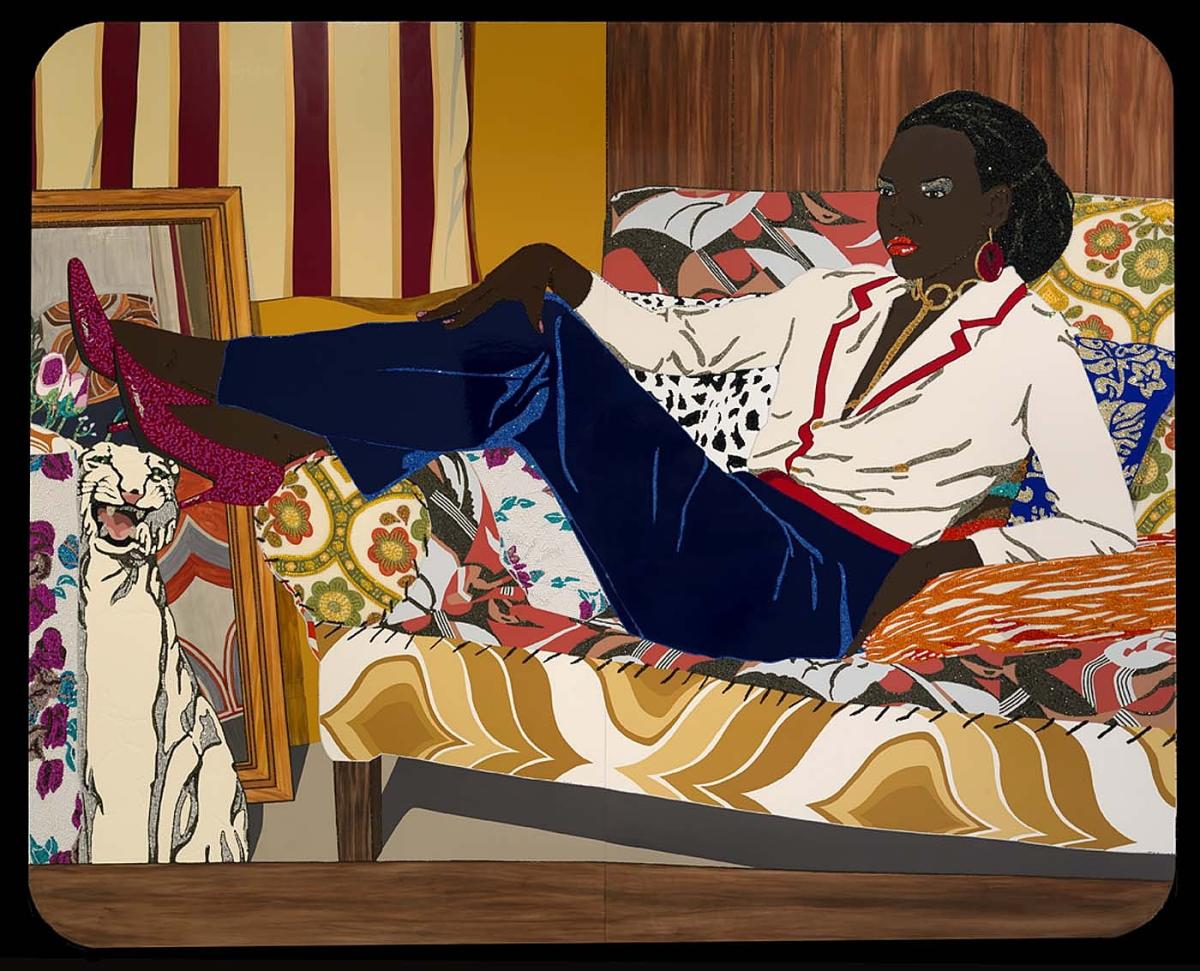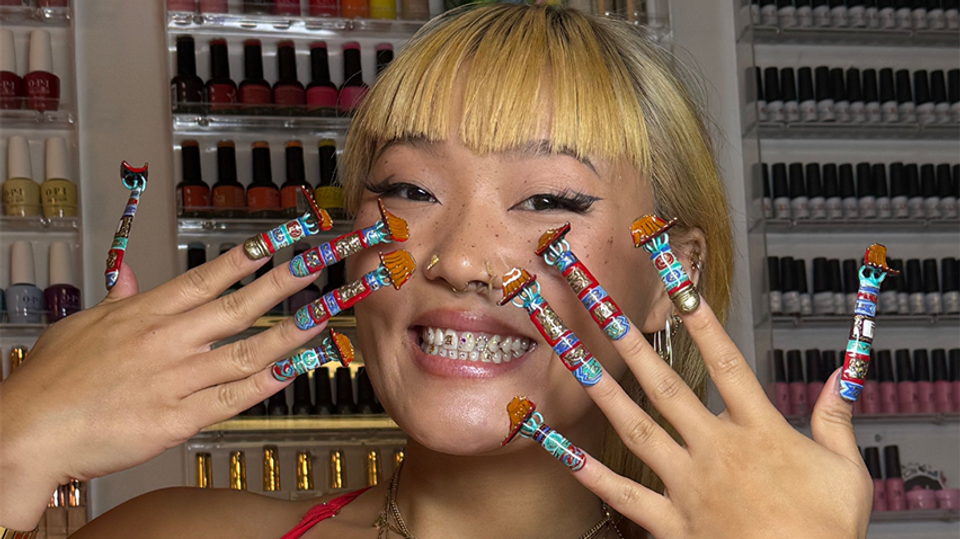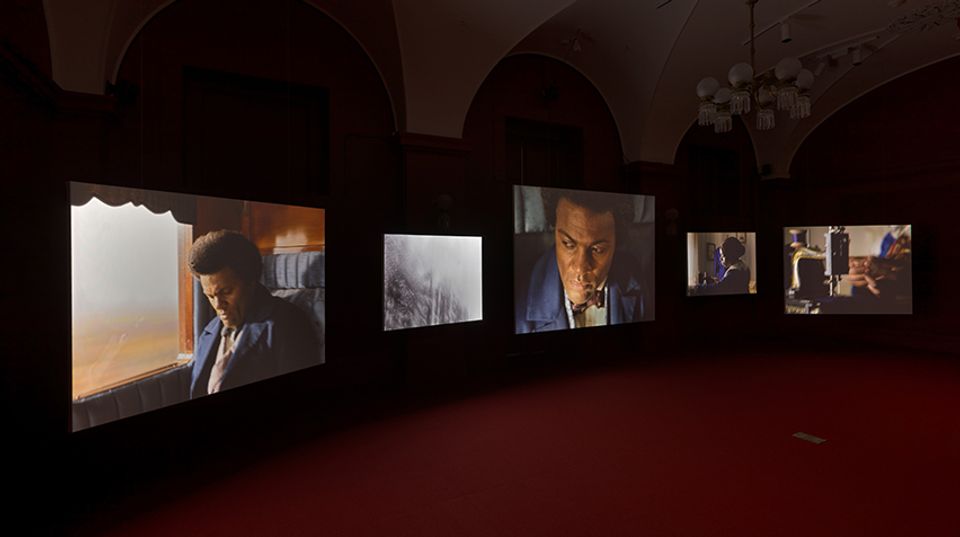
SAAM’s website and physical spaces hold artworks and resources aplenty to take a deep dive into the presence and impact of African American artists on our world. In honor of Black History Month, here are a few of our favorite videos of artists speaking about their life, work, and inspiration.
In search of more resources and art? SAAM is home to one of the most significant collections of works by African American artists in the world. Browse artworks, more videos, and other resources on our highlights page.
Bisa Butler
Explore the multilayered historical meanings and stories behind Bisa Butler’s monumental quilted portraits. Butler blends the line between art and craft and portrays Black life and cultural identity with striking originality. Learn more about how Butler’s matrilineal sewing legacy, patrilineal Ghanaian roots, and the AfriCOBRA art movement resonate in her inventive quilting technique. She also shares how the current Black Lives Matter cry for racial justice and COVID-19 have influenced her present and future work.
- Chapters
- descriptions off, selected
- captions off, selected
This is a modal window.
On Friday, November 20, 2020, SAAM presented a virtual lecture featuring fiber artist Bisa Butler. Explore the past, present, and future and discusses how familial, educational, and societal influences Butler to blend the line between art and craft. Butler is known for creating monumental quilted portraits of Black life and cultural identity with striking originality that share multilayered historical meanings and stories. Learn more about how Butler’s matrilineal sewing legacy, patrilineal Ghanaian roots, and the AfriCOBRA art movement resonate in her inventive quilting technique. Butler also shares how the current Black Lives Matter cry for racial justice and COVID-19 have influenced her work as she looks to creating in the future.
This program is part of our annual Clarice Smith Distinguished Lectures in American Art series, which presents new insights in American art from the perspectives of outstanding artists, critics, and scholars. The series is made possible by the generosity of Clarice Smith.
Sonya Clark
Sonya Clark discusses how her work speaks to intersecting themes of history, race, and culture in the United States. Clark is joined in conversation by Nora Atkinson, the Fleur and Charles Bresler Curator-in-Charge of the Renwick Gallery of the Smithsonian American Art Museum. From human hair and combs to flags and U.S. currency, Clark utilizes unconventional craft materials to create powerful artworks that inspire reflection on who we are individually, collectively, and as part of an imperfect nation. Clark also discusses how the global pandemic and compounded challenges of 2020 shaped her creative practice.
- Chapters
- descriptions off, selected
- captions off, selected
This is a modal window.
Celebrated artist Sonya Clark discusses how her work speaks to intersecting themes of history, race, and culture in the United States. Clark is joined in conversation by Nora Atkinson, the Fleur and Charles Bresler Curator-in-Charge of the Renwick Gallery of the Smithsonian American Art Museum. From human hair and combs to flags and U.S. currency, Clark utilizes unconventional craft materials to create powerful artworks that inspire reflection on who we are individually, collectively, and as part of an imperfect nation. Clark also discusses how the global pandemic and compounded challenges of 2020 shaped her creative practice.
This program was part of the Smithsonian American Art Museum’s annual Director’s Circle Dinner in 2020.
Fred Wilson
Fred Wilson has left his mark on the American and international art and craft world through his innovative installations and sculpture that challenge assumptions of history, culture, race. In this engaging discussion, he traces his artistic career and process through many decades, mediums, and techniques. Wilson is known for his examination of museum practices, starting with his landmark intervention Mining the Museum (1992–93). By exploring how objects and cultural symbols are displayed in museums and reframing them in new ways, Wilson alters traditional interpretations and encourages viewers to reconsider how they see history.
- Chapters
- descriptions off, selected
- captions off, selected
This is a modal window.
On Wednesday, September 15, 2021, the Smithsonian American Art Museum hosted a virtual lecture with creative powerhouse Fred Wilson. During this captivating virtual lecture, Wilson traces his artistic career and process through many decades, mediums, and techniques. He is known for challenging assumptions of history, culture, race, and conventions of display by reframing objects and cultural symbols, altering traditional interpretations, and encouraging viewers to reconsider social and historical narratives.
Wilson has left his mark on the American and international art and craft world. From his earliest museum intervention, Mining the Museum (1992–93), and his selection at the American Pavilion of the 2003 Venice Biennale, to his newfound practice in glassworks, and most recently, a project titled Afro Kismet, which comprises glassworks, museums, and the history of Venice and Istanbul. The Smithsonian American Art Museum is honored to include his 2013 glass and woodwork piece I Saw Othello’s Visage In His Mind in our collection and host him as the first speaker in our annual series, the Clarice Smith Distinguished Lectures in American Art.
This program is part of our annual Clarice Smith Distinguished Lectures in American Art series, which presents new insights into American art from the perspectives of outstanding artists, critics, and scholars. The series is made possible by the generosity of Clarice Smith.
Kerry James Marshall
One of the leading contemporary painters of his generation, Kerry James Marshall has become internationally known for monumental images of Black history and culture. In this video, Marshall discusses the intent behind his painting SOB, SOB, and looks closely at the different elements—from the books on the shelves to the clothing that the figure wears. Dominated by visually powerful Black figures, Marshall confronts viewers and challenges the field of art and art history, which is still grounded in European works and portrays mostly white figures. In doing so, he shifts the narrative of the painting but also the broader narrative of American art.
- Chapters
- descriptions off, selected
- captions off, selected
This is a modal window.
An interview with artist Kerry James Marshall at the Smithsonian American Art Museum. Kerry James Marshall is one of the leading contemporary painters of his generation. Over the span of his career, he has become internationally known for monumental images of African American history and culture.
Really, in order to have a complete understanding of where you are situated in your own present moment, you have to locate yourself in relationship to some parts of history. That's a lot of what this picture is kind of about.
If you came to my house and looked through my library, you would see my wife and I have a huge concentration of books that are on African history, African-American history, American history, African culture. All of those different aspects of the history of Black people from around the world. If you look through the titles of the books, you'll see that the range of subjects that they cover relative to Black history, culture, and also the kinds of stories that Black people tell is really broad.
A part of the reason some of those titles are there is to introduce some of those authors and some of those books to the art viewing public. The painting is as much an invitation to also come to know as it is demonstration of the kind of conflicts in knowledge that somebody who has already arrived at this knowledge might experience.
Our conception of what constitutes the best that can be done in artwork still revolves around those paintings that are the foundation of art history, and those paintings all have a European origin. Our concept of what's beautiful and what's important operates within that realm, as well. For me, as an African American or a Black person going to the museum and looking at those works, even though I like a lot of things I might be looking at, there really is a limit to your ability to appreciate things that don't include you as a fundamental part of their value system.
For me, the only way to really come to terms with that is to introduce images that contain Black figures and not Black figures they were marginal in terms of their position in the narrative but central to the narrative. I committed myself to only making Black figures in my paintings because there are not enough paintings in museums anywhere, really, that have black figures as the central subject of those pictures.
One of the devices artists use to encourage people to think again about the importance of a thing is to change the scale of the object. If you have things that we're used to seeing in a really small format, if you double that size or increase it exponentially, then all the sudden it assumes a lot more importance than it would have if it remained at the scale that we commonly experience those things at.
I did make the frame. It's a way of kind of locating it amongst the kind of common, popular, vernacular approach. It seems like something that’s more familiar to people who often think of museums and artworks as really, really distant from their experiences. If you come up to a thing that has got this really ornate, gold frame and you look at the picture inside and you don't like it, then that becomes that thing where people say, “Well, I just must not be smart enough.” Those people don't come back to the museum, more times than not.
A part of what I was trying to do was to create a garment that didn't have a place in time—that couldn't be located as a kind of ‘70s fashion, or ‘80s fashion, or ‘50s fashion because there's nothing like that that has ever existed. It becomes a curious artifact of the picture. It's sort of this ambivalent zone, too, so you can't quite place it. You don't quite know what it is. It's odd, and it's sort of intriguing in a way. So that's a part of what I was trying to do. This is early on in the process. I had never really sewn a thing before in my life.
I wanted to try to convey, or at least give people access to, was a certain level of ambivalence in what the character or the figure was thinking after having read through and gone through some of those books. The thought balloons there and the phrase, “SOB, SOB,” those two sounds. Yes, it's, on the one hand, a kind of sad recognition of some sort of painful insight, maybe. But on the other side of it, it's a fairly powerful rebuke of some of the things you might have come to learn in history. I think that ambivalence, that place in between where you experience both a certain sadness and also a certain kind of anger about the things that you've discovered. This is really a part of what the picture is about. Then the question becomes after you began to know those things that one cannot not know, then what do you do with that information? What do you do with it? What do you do about it?
The most important achievement I can make, on the one hand, is to first have this work have arrived at the Smithsonian. The fact that it's here is a great achievement. Anybody who walks through the building can look at it or not look at it, but if it wasn't there, then they wouldn't have that option. Then by the extension from there, it becomes as much a part of the narrative what has value in art history as anything that had already been there. Those two things are more important for me than anything else that accompanies what people call success in the art world. That matters the most.
When I hear from some young person that they saw a picture of mine and that it had an impact on them, I feel that, well, I guess it's a good day and it's all been worthwhile.
Mickalene Thomas
In these "Meet the Artists" videos, Mickalene Thomas discusses the unlimited creativity that comes with the use of non-traditional and craft materials. She examines the Black artists that were influential in her career and the importance of seeing oneself represented in museums. In the second video, Thomas explores her most iconic work, Portrait of Mnonja.
- Chapters
- descriptions off, selected
- captions off, selected
This is a modal window.
Artist Mickalene Thomas discusses her use of craft materials, her artistic influences, and the importance of seeing oneself represented in museums. Read a web comic from Drawn to Art that illustrates the artist's words.
I guess my appeal to craft materials is also another historical reference to women making art. When I was in undergrad, I couldn't always afford oil paint. Because I was in a school and still had to make work, I had to figure out ways in which to still make my art and not limit myself to “I can't make my art, because I don't have oil paint or acrylic paint.” So I gravitated toward non-traditional materials that were considered maybe, for some, a low art, but also to others a high art, if you look at outsider artists, right? I began going to Michaels craft stores, because I could afford felt, and I could afford yarn, and I could afford these little bags of rhinestones or glitter. I could get an abundance of those versus a tube of paint.
I began to acquire these materials and find meanings and ways to use them in my own work as a way of identifying myself but also making an image. That's something that I also push forward with some of my students is not to limit yourself with what you can't do, but just try to think of what you can do and use those materials that are within your own environment to make something.
When I was living in Portland, Oregon I would go to this bookstore called Powell's Books. Within the stacks of their books, I would just go up and down the aisle pulling out books on African-American artists. I remember looking at a William H. Johnson monograph and thinking at that time, "Oh, this is catalogue raisonné" and thinking how his sensibility of his line, representation of his journeys, and the people in his environment, and depicting his world, and depicting African-American lifestyles was a direct representation of who I was. It's really important for me, as an artist, to have a representation of myself so that youth could see themselves in these particular environments like museums. When they see my work, with all the art history, whether it's from William H. Johnson, to someone like David Hockney or Matisse, that when they're standing here that they see themselves.
- Chapters
- descriptions off, selected
- captions off, selected
This is a modal window.
Artist Mickalene Thomas discusses her work Portrait of Mnonja. Thomas explains her inspirations for the painting, the role that performance plays in her practice, and the connection between Portrait of Mnonja and Ambassador Susan Rice.
I would say the essence of Mnonja in this painting is power, sophistication, beauty, and also a little vulnerability. I think most of my sitters and the women that I gravitate towards have all of those attributes that I look for and want to convey in my work. For this particular one I feel like she’s owning and claiming her space, which is very exciting. Looking at her up close, I’m always looking for, “Oh, I could have made it this way or that way,” but I think she’s just made exactly the way she needs to. I think she represents the American experience because she represents a whole line of women that have come before her and women that are coming after her.
I was asked to make this painting for Arts and Embassies for Ambassador Susan Rice. I thought that it would be really important to convey a female figure from my perspective and from my practice, someone who imbued the sense of what Susan Rice represented at that particular time and political stance and power but also patriotic. That’s why looking through all of my clothes that I had for Mnonja, I selected these particular colors, really subtle signifiers that would represent our flag but also represent the United States and represent Susan Rice’s position and also represent her being this African-American woman in this highly profiled position and a sense of power.
Performance plays a huge role in my practice, and I like to think that my work with any of the models that come to my space is a collaborative act. What I do and the hope is that we are both contributing almost like two dancers that come for a performance. I often think and believe that portraiture is a representation of the person who’s painting them and that a lot of times the sitters become a vehicle for the person, for the artist. I use everything in the work as how I see myself. They become sort of these stand-ins for me, and in some level they may be considered mostly self-portraits.


















